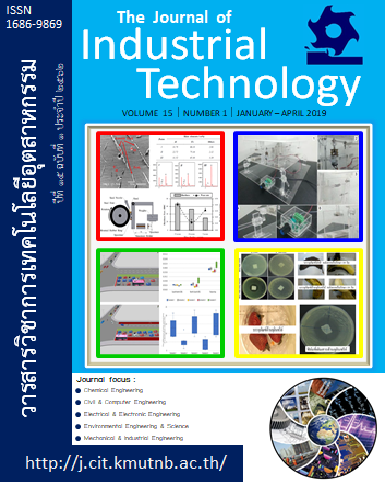(บรรจุภัณฑ์อาหารต้านจุลินทรีย์จากพลาสติกย่อยสลายได้ทางชีวภาพ ผสมน้ำมันหอมระเหย)(Antimicrobial Packaging from Biodegradable Plastics and Essential Oils Blends)
Keywords:
Bioplastics, Food packaging, Antimicrobial packaging, Mass transferAbstract
The interaction between food and packaging was unacceptable in the past. It was believed to be altered the food quality. However, numerous literatures have proven that the specific interactions between food and packaging do not affect the quality of the food and it can also slow down the deterioration of food. Antimicrobial packaging technology is one of the concepts that induce interactions between food and packaging while maintaining the food properties, safety and nutritional quality. Generally, the additives used as an antimicrobial agent are essential oils, which extracted from plants. These essential oils are able to inhibit the growth of fungus, yeast, bacteria, food spoilage and pathogenic microorganisms. Bioplastics is expected to replace plastics from petroleum in the near future. Commercially, bioplastics were used for the food packaging applications due to their good mechanical properties and biodegradability. To reduce the plastic wastes together with the shelf life extension of food, many researchers have developed antimicrobial bioplastic packaging in the past decade. This article discusses the introduction to bioplastics, deterioration of food due to microorganisms, migration of antimicrobial agents from packaging to food as well as the antimicrobial packaging technology with various foods.
References
[2] N. Petchwattana and P. Naknaen, “Influence of packaging material and storage time on physical, chemical and microbiological properties of set yogurt: A comparative study between modified biodegradable poly(lactic acid) and polypropylene”, Journal of Engineering Science and Technology, 11, 2016, pp. 1437-1449.
[3] Y. Sriwirat and K. Tanta, “Formulation development for biodegradable packaging: Polybutylene succinate and cellulose acetate butyrate blends”, Naresuan Phayao Journal, 8, 2015, pp. 174-177. (In Thai)
[4] C. Dong, Y. Mei, and L. Chen, “Simultaneous determination of sorbic and benzoic acids in food dressing by headspace solid phase microextraction and gas chromatography”, Journal of Chromatopgraphy A, 1117, 2006, pp. 109-114.
[5] B. Malhotra, A. Keshwani and H. Kharkwal, “Antimicrobial food packaging: potential and pitfalls”, Frontiers in microbiology, 6, 2015, pp. 1-9.
[6] M.V. Guettler, D. Rumler and M.K. Jain, “Actinobacillus succinogenes sp. nov., a novel succinic acid producing strain from the bovine lumen”, International Journal of Systematic Bacteriology, 49, 1999, pp. 207-216.
[7] G.N. Vemuri, M.A. Eiteman and E. Altman, “Succinate production in dual-phase Escherichia coli fermentations depends on the time of transition from aerobic to anaerobic conditions”, Journal of Industrial Microbiology and Biotechnology, 28, 2002, pp. 325-332.
[8] P. Paoprasert, “Polymers from biological sources: A literature review”, KKU Research Journal, 18, 2013, pp. 536-547. (In Thai)
[9] S. Chouhan, K. Sharma and S. Guleria, “Antimicrobial activity of some essential oils—Present status and future perspectives”, Medicines (Basel), 4, 2017, 58.
[10] Y.X. Seow, C.R. Yeo, H.L. Chung and H.G. Yuk, “Plant essential oils as active antimicrobial agents”, Critical Reviews in Food Science and Nutrition, 54, 2014, pp. 625-644.
[11] J.H.J. Huis in't Veld, “Microbial and biochemical spoilage of foods: an overview”, International Journal of Food Microbiology, 33, 1996, pp. 1-18.
[12] P. Lertsatitthanakorn, K. Montree, J. Bunjong, B. Samrual and S. Kotchan, “Antimicrobial activities of Cinnamomum zeylanicum blume bark essential oil”, Thai Pharmaceutical and Health Science Journal, 7, 2012, pp.39-43. (In Thai)
[13] P. Appendini and J. H. Hotchkiss, “Review of antimicrobial food packaging”, Innovative Food Science & Emerging Technologies, 3, 2002, pp. 113–126.
[14] A. Kositchaiyong, C. Thongpin, K. Sombatsompop, C. Chandavasu, T. Markpin, E. Wimolmala and N. Sombatsompop, “Material characterizations and anti-bacterial performances of triclosan containing high-density polyethylene”, Journal of Research and Innovation for Thai Industries, 1, 2010, pp. 16-27. (In Thai)
[15] A.W. Bauer, W.M. Kirby, J.C. Sherris and M. Turck, “Antibiotic susceptibility testing by a standardized single disk method”, American Journal of Clinical Pathology, 45, 1966, pp. 493–496.
[16] L.B. Reller, M. Weinstein, J.H. Jorgensen and M.J. Ferraro, “Antimicrobial susceptibility testing: A review of general principles and contemporary practices”, Clinical Infectious Diseases, 49, 2009, pp. 1749–1755.
[17] T. Jin and H. Zhang, “Biodegradable polylactic acid polymer with nisin for use in antimicrobial food packaging”, Journal of Food Science, 73, 2008, pp. M127-M134.
[18] M. Mastromatteo, A. Danza, A. Conte, G. Muratore and M.A. Del Nobile, “Shelf life of ready to use peeled shrimps as affected by thymol essential oil and modified atmosphere packaging”, International journal of food microbiology, 144, 2010, pp. 250-256.
[19] Y. Zhao, J. Qu, Y. Feng, Z. Wu, F. Chen, and H. Tang, “Mechanical and thermal properties of epoxidized soybean oil plasticized polybutylene succinate blends”, Polymers for Advanced Technologies, 23, 2012, pp. 632-638.
[20] J.H. Han, “Antimicrobial food packaging”, In: R. Ahveniainen (Ed.) “Novel food packaging techniques”’ 1st ed. Woodhead Publishing, Cambridge. 2003.
[21] V.H. Campos-Requena, B.L. Rivas, M.A. Pérez, C.R. Figueroa, E.N. Figueroa and E.A. Sanfuentes, “Thermoplastic starch/clay nanocomposites loaded with essential oil constituents as packaging for strawberries-In vivo antimicrobial synergy over Botrytis cinerea”, Postharvest Biology and Technology, 129, 2017, pp. 29-36.
[22] M.M.H. Senna, K.M. Al-Shamrani and A.S. Al-Arifi, “Edible coating for shelf-life extension of fresh banana fruit based on gamma irradiated plasticized poly(vinyl alcohol)/carboxymethyl cellulose/tannin composites”, Materials Sciences and Applications, 5, 2014, pp. 45851.
[23] M. Ramos, A. Beltran, A. Valdes, M.A. Peltzer, A. Jimenez, M.C. Garrigos and G.E. Zaikov, “Carvacrol and thymol for fresh food packaging”, Journal of Bioequivalence & Bioavailability, 5, 2013, pp. 154-160.


